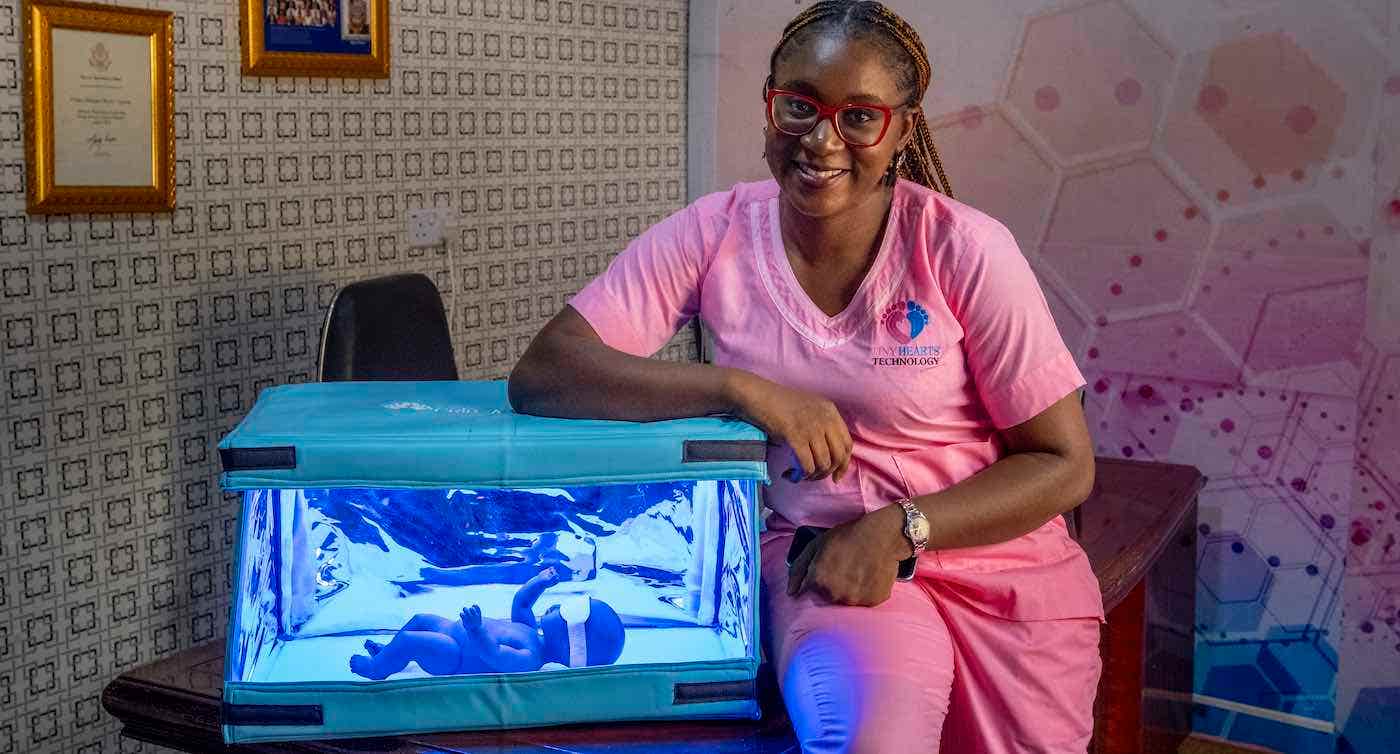Mom designs solar-powered cribs that save babies with jaundice
Virtue Oboro’s Crib A’ glow invention aims to save infants with jaundice, a condition that affects millions of infants.

[Mar 16, 2022: Lucia Kenig-Ziesler, Borgen Magazine]
Virtue Oboro’s Crib A’ glow invention aims to save infants with jaundice.. (CREDIT: Benson Ibeabuchi/GGImages/RAEng)
SEATTLE, Washington — Though much of today’s healthcare is focused around the COVID-19 crisis, there are many other illnesses and diseases wreaking havoc around the world. Tuberculosis continues to be the world’s most lethal disease and many impoverished countries have the largest percentage of deaths attributed to diarrheal and neonatal diseases. One disease that has been highlighted by a recent innovator’s success is jaundice. Virtue Oboro’s Crib A’ glow invention aims to save infants with jaundice.
What is Jaundice?
Jaundice, a condition that affects millions of infants, occurs when levels of bilirubin in the blood are too high and not properly processed by the body. This is all too common because many infants, especially those that are premature, often haven’t developed the liver function to properly process the bilirubin. This excess bilirubin leads to jaundice, a medical condition that without treatment can lead to brain damage, cerebral palsy, hearing loss, blindness and even death.
When Virtue Oboro was faced with a personal experience of the dangers of jaundice, she set out to find a way to eradicate jaundice in infants and give millions of children with jaundice a chance to find treatment before irreversible mental damage occurred.
Related Stories:
A Harrowing Story
Virtue Oboro first became involved in the healthcare industry because of her son’s own brush with jaundice. Oboro is from Nigeria, the most highly populated country in Africa, where citizens are at significant risk for contracting disease.
In 2015, shortly after giving birth, Oboro began to notice the classic yellow hue in her son so commonly associated with the disease. Within two days of his birth, he was diagnosed with jaundice but due to a lack of available phototherapy units in the hospital, his condition worsened to the point that he needed a blood transfusion. Her son survived but the ordeal changed Oboro forever.
According to the CIA website, the degree of risk for major infectious diseases is classified as ‘very high.’ Along with high rates of disease like Lassa fever and meningitis, the country has the 31st highest percentages of cases of HIV/AIDS. Jaundice is just yet another illness to afflict the country.
Phototherapy exposes infants to light, and gets rid of the excess bilirubin in their system. (CREDIT: Tiny Hearts / Facebook)
The World Health Organization predicts that over six million infants each year suffer from untreated neonatal jaundice, and Oboro’s son was among them.
Oboro’s Solution
After her son’s experience fighting jaundice, Oboro decided she couldn’t sit back and watch as other children suffered from the very treatable disease. Despite all of the dangerous side effects of severe jaundice, when diagnosed, the disease is very treatable. Knowing this, she decided to team up with scientists and researchers to learn about what she could be doing to save infants’ lives from jaundice.
She quickly learned that there were a myriad of reasons that so many infants were dying from this disease, most prominently the lack of technology and treatment options. One available treatment, Phototherapy, exposes infants to light, and gets rid of the excess bilirubin in their system. She learned, however, that in many hospitals, there were not nearly enough units that could provide infants with the necessary light therapy, along with a general ignorance of both the dangers and severity of the disease.
After gathering data and consulting with experts, Oboro started the company Tiny Hearts Technologies, a company devoted to making solar-powered phototherapy cribs. She named the units “Crib A’ glow.” She worked with a pediatrician throughout the design process to ensure all details were beneficial to the tiny babies and with her husband on the power requirements for the crib as he had previous experience working with solar panels.
Crib A’ glow removes the barriers of access, cost and inconsistent power supplies that make treatment so difficult. Made in Nigeria, Crib A’ glow, costs one-sixth the price of a standard phototherapy crib.
Next Steps
Today, Oboro continues to make strides in eradicating neonatal jaundice and raising awareness around Nigeria. So far, Virtue Oboro’s Crib A’ glow units have treated over 2000 infants and Oboro is dedicated both to using social media and implementing sensitization programs to spread awareness. She even founded a program called Yellow Alert, whose goal is to increase awareness of the signs of jaundice among new parents and medical workers.
Due to her innovations and her efforts to improve the healthcare of her country, Oboro received the 2019 Young Entrepreneurs Award and was awarded a $50,000 grant from Johnson & Johnson through the Africa Innovation Challenge. Virtue, was also awarded The Africa Prize for Engineering Innovation in 2022.
The Crib A’Glow can now be found in over 500 hospitals across Nigeria and neighboring Ghana and has been used with over 500,000 babies.
In the future, she hopes that the units can be implemented in every Nigerian hospital, especially ones in rural communities where no phototherapy units currently exist. While Oboro’s invention is just the first step in jaundice awareness and treatment, it’s one step closer to saving millions of children.
Note: Materials provided above by Borgen Magazine. Content may be edited for style and length.
Like these kind of feel good stories? Get the Brighter Side of News' newsletter.
Tags: #New_Innovations, #Global_Good_News, #Medical_News, #Technology, #Babies, #Cribs, #Jaundice, #Light_Therapy, #Solar_Power, #The_Brighter_Side_of_News



